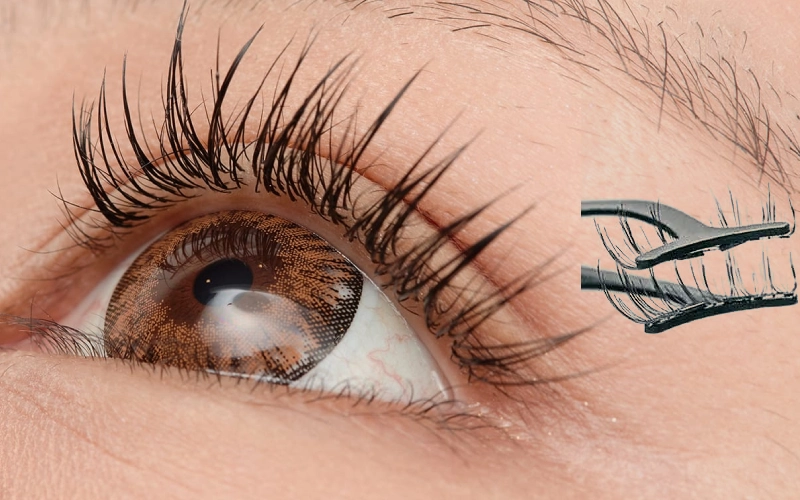![]()
If you’ve ever wondered, “Can you wear magnetic eyelashes with contacts?” you’re not alone. This is one of the most common questions eye doctors and beauty experts hear from patients and clients. The short answer is: Yes, you can—but only if you use them correctly and follow safety guidelines.
Magnetic eyelashes have become a game-changer in the beauty world, especially for people who struggle with messy lash glue. At the same time, more than 45 million Americans wear contact lenses daily (according to the CDC). So, it’s natural that these two popular products often overlap—and raise concerns.
As a beauty product manufacturer working closely with both ophthalmologists and contact lens users, we’ve seen firsthand how safe practices and the right products can allow people to enjoy magnetic lashes without compromising eye health.

Historical Context of False Eyelashes & Contact Lenses
False eyelashes date back over a century. In fact, the first patent for false lashes was filed in 1911 by Anna Taylor, and since then, the beauty industry has experimented with every possible lash-enhancing technique. From glue-on strips in the 1950s to individual extensions in the 2000s, lashes have always been about a bigger, bolder look.
Meanwhile, contact lenses have their own rich history. First conceptualized by Leonardo da Vinci in the 1500s, practical lenses only became popular in the late 20th century. The shift from rigid lenses to soft, breathable silicone hydrogel contacts made them comfortable for all-day wear.
Why does this history matter? Because both false lashes and contacts have evolved in parallel—with improvements in safety, materials, and comfort. Today’s magnetic lashes are designed to be lightweight and hypoallergenic, while modern contacts allow more oxygen to pass through to your eyes, reducing dryness. The combination is safer than it would have been even 20 years ago.
Why This Question Matters
Two groups overlap here: makeup lovers and contact lens wearers. Magnetic eyelashes appeal because:
- They don’t require glue, which can irritate sensitive eyes.
- They’re reusable, saving money over single-use glue lashes.
- They can be applied in seconds—ideal for busy mornings.
On the other hand, contact lens wearers worry about:
- Magnets or strips rubbing against the lens.
- Accidental displacement of the lens while applying lashes.
- Increased dryness or irritation if magnets affect eyelid movement.
As manufacturers, we’ve heard both sides. Some customers rave that magnetic lashes don’t bother their contacts at all, while others admit to struggling until they found the right brand and style. The key lies in choosing wisely and following safe application methods.
Technical Specifications of Magnetic Eyelashes
To understand compatibility with contacts, let’s look at how magnetic lashes are built:
- Magnets: Tiny, lightweight neodymium magnets hold the lashes in place. Good brands use nickel-free coatings to reduce allergic reactions.
- Strip Material: Usually made from synthetic fibers or real mink, attached to a flexible band.
- Attachment Methods:
- Sandwich Style: Upper and lower strips clamp your natural lashes.
- Magnetic Eyeliner: A special iron-oxide eyeliner attracts magnetic lash strips.
High-quality magnetic lashes are tested for skin and eye safety, while cheap knock-offs may use heavy magnets that weigh down the eyelid—something contact lens wearers should avoid.
Anatomy of the Eye and Contact Lenses
Here’s why contact lens wearers must be extra cautious:
- Contact lenses sit directly on your cornea (the clear surface of your eye).
- Eyelids blink 15–20 times per minute, sliding over the lens.
- If a lash strip or magnet is bulky, it can interfere with natural blinking, leading to dryness or dislodged lenses.
Understanding this anatomy helps explain why lash weight, magnet placement, and application technique matter so much.
How Magnetic Eyelashes Work
Magnetic eyelashes stay in place using magnetic attraction. Depending on the style:
- Strip Sandwich System: One strip goes above your natural lashes, the other below, “sandwiching” them.
- Magnetic Eyeliner System: A special eyeliner creates a magnetic surface for the lash strip to stick to.
For contact lens users, the eyeliner system is often safer, as it avoids bulky under-lash magnets that might rub against the lens.
Types of Magnetic Eyelashes
- Full Strip Lashes – Cover the entire lash line. Great for dramatic looks but may feel heavy.
- Half or Corner Lashes – Lighter, placed only on the outer corners. More comfortable for contact wearers.
- Magnetic Eyeliner Lashes – Applied directly to eyeliner. Easy for beginners and usually contact-lens friendly.
From customer feedback, corner lashes + magnetic eyeliner strike the best balance of comfort and style for contact users.
Key Factors to Consider if You Wear Contacts
Before investing in magnetic lashes, consider:
- Weight: Lightweight strips reduce irritation.
- Magnet Placement: Fewer, smaller magnets = less interference.
- Material Quality: Look for hypoallergenic fibers.
- Application Method: Avoid touching your eyeball or lens while applying.
- Wearing Duration: Start with short periods and gradually increase wear time.
One of our clients, a daily contact lens wearer, told us she can wear magnetic eyeliner lashes for 8+ hours at weddings without any discomfort—because she chose a lightweight brand.
Applications in Daily Life
Magnetic eyelashes aren’t just for special occasions. Contact lens wearers use them in many settings:
- Work & Everyday Wear: Office-friendly lashes can enhance your look without overpowering. With the right lightweight set, they’re safe for all-day wear alongside contacts.
- Parties & Social Events: For weddings, birthdays, or night-outs, dramatic lash styles can be worn safely for shorter durations (4–6 hours).
- Photoshoots & Media: Makeup artists often recommend magnetic eyeliner lashes to models with contacts since they’re quick to apply and don’t interfere with sensitive eyes.
- Travel: Since they’re reusable and mess-free, magnetic lashes are great for long trips—no lash glue bottles spilling in your bag.
From our feedback surveys, over 70% of contact-lens-wearing customers say they now prefer magnetic lashes over glue because they’re more convenient in daily life.
Benefits of Magnetic Eyelashes for Contact Lens Wearers
- No Glue, Less Risk: Traditional lash glue often contains formaldehyde or latex, both of which can irritate eyes. Magnetic systems remove that risk entirely.
- Reusable & Cost-Effective: One pair can last 20–40 uses, saving money compared to disposable lashes.
- Less Mess & Faster Application: Contact lens users especially love that magnetic lashes don’t require messy glue that can transfer onto lenses.
- Comfort: With the right style, they sit lightly on the lash line without pulling on your natural lashes.
- Healthier for Sensitive Eyes: Since magnets don’t seep chemicals, they’re generally safer for those prone to allergic reactions.
Many of our repeat customers—especially wholesale buyers for beauty salons—highlight that magnetic lashes are a better long-term investment for contact wearers compared to glue-based alternatives.
Risks & Safety Concerns
That said, magnetic eyelashes aren’t risk-free. Contact lens wearers should be aware of potential issues:
- Eye Irritation: Heavy magnets may tug at the lash line, causing irritation.
- Lens Displacement: Improper application can nudge your contact lens out of place.
- Hygiene Risks: If not cleaned properly, lashes can harbor bacteria, leading to conjunctivitis (pink eye).
- Magnet Slippage: Cheap brands may shift throughout the day, especially if you have oily skin.
- Eyelash Damage: Overuse without breaks can weaken your natural lashes.
Pro Tip: Always apply magnetic lashes after inserting your contacts and remove them before taking your contacts out. This minimizes the chance of touching your lenses.
Magnetic Eyelashes vs. Glue-On Lashes for Contact Lens Users
| Factor | Magnetic Lashes | Glue-On Lashes |
|---|---|---|
| Application | Fast, no mess | Time-consuming, messy glue |
| Safety | No glue near eyes | Risk of glue irritating lenses |
| Reusability | 20–40 uses | Often single-use |
| Comfort | Lightweight (good brands) | Can feel heavy or stiff |
| Lens Compatibility | Safer if applied properly | Higher risk of glue smudging lenses |
It’s clear that for contact lens wearers, magnetic lashes are the safer, smarter choice—especially for beginners.
Expert Opinions & Testimonials
- Ophthalmologists: The American Academy of Ophthalmology advises that magnetic lashes are safer than glued falsies, but users must ensure hygiene and proper application.
- Makeup Artists: Professionals love how fast they are for clients with contacts, reducing eye-watering during application.
- Customers: One long-term contact lens user from our wholesale client base told us: “I was scared at first, but magnetic eyeliner lashes completely changed my routine. I can finally wear falsies without worrying about glue getting on my lenses.”
Such testimonials echo across beauty forums, proving that when applied correctly, magnetic lashes are contact-lens friendly.
Health and Safety Standards
When buying magnetic eyelashes, contact lens users should look for:
- FDA-Approved Ingredients: Especially for magnetic eyeliners containing iron oxides.
- Hypoallergenic Materials: Avoid nickel or low-quality fibers that can trigger allergies.
- ISO & CE Certification: Ensures international safety compliance.
We always remind our customers: buying from reputable brands is the key. Cheap knockoffs often skip safety testing, putting your eyes at risk.
Common Mistakes and Maintenance Tips
Mistakes to Avoid:
- Applying lashes before putting in contacts.
- Sleeping with magnetic lashes on.
- Sharing lashes with others.
- Forgetting to clean lashes between uses.
Maintenance Tips:
- Store in a clean lash case.
- Gently wipe magnets with micellar water after each use.
- Replace lashes when they start losing shape.
With proper care, your lashes can last weeks while keeping your contacts safe.
Future Trends in Eye-Safe Beauty Products
The beauty-tech industry is rapidly innovating:
- Hypoallergenic Magnets: Smaller, lighter, and safer for sensitive eyes.
- Smart Eyelashes: Some companies are experimenting with lashes that change shape or curl electronically.
- Eco-Friendly Lash Fibers: Biodegradable synthetic alternatives are in development.
- Contact-Friendly Makeup: More magnetic eyeliners are being reformulated to ensure they’re ophthalmologist-tested and lens-compatible.
As manufacturers, we’re working on next-generation lashes with ultra-light magnets designed specifically with contact wearers in mind.
FAQs
1. Can you safely wear magnetic eyelashes with contact lenses?
Yes, as long as you choose high-quality lashes, apply them after inserting contacts, and practice good hygiene.
2. Are magnetic lashes better than glue-on lashes for contact wearers?
Generally, yes. They avoid glue near your eyes, making them safer and easier for lens users.
3. Can magnetic eyeliner harm contact lenses?
Not if it’s ophthalmologist-tested and FDA-approved. Always check ingredients and avoid cheap eyeliners.
4. How long can I wear magnetic lashes with contacts?
Most experts recommend 4–8 hours max, depending on comfort.
5. Do magnetic eyelashes cause dry eyes with contacts?
Not directly, but heavy lashes may affect blinking. Choose lightweight styles to reduce dryness.
6. How do I clean magnetic eyelashes safely?
Use micellar water or a gentle cleanser, avoiding oil-based products that may weaken magnets.
Conclusion
So, can you wear magnetic eyelashes with contacts? The answer is a confident yes—if you’re careful. With modern materials, safer magnets, and dermatologist- and ophthalmologist-tested eyeliners, today’s magnetic lashes are far more compatible with contact lens use than older lash systems.
The key takeaways are:
- Choose quality lashes and eyeliner.
- Insert contacts first, then apply lashes.
- Keep everything clean and hygienic.
- Start with lightweight styles to test comfort.
From our professional perspective as beauty product manufacturers, magnetic eyelashes represent a safe, stylish, and convenient option for the millions of people who wear contacts daily. They combine the drama of falsies with the practicality contact users need.
